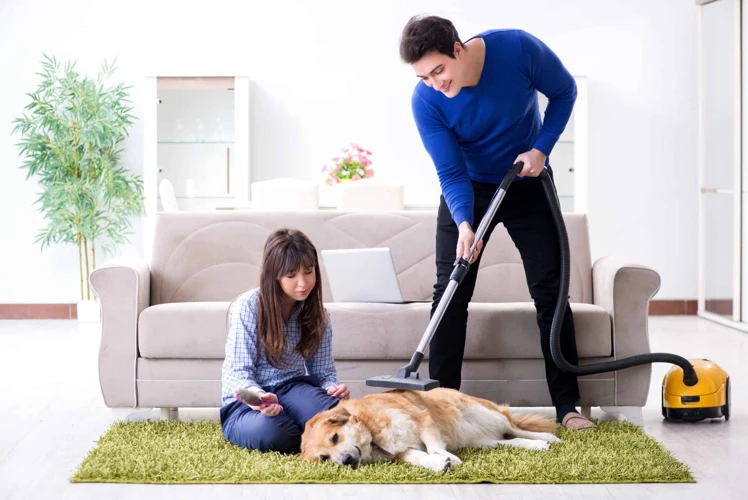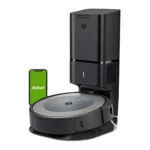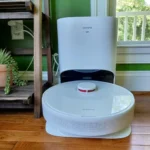As a pet owner, it can be a real challenge to keep your furry friend calm and collected during the smart vacuum cleaning process. While these innovative devices are a valuable asset for maintaining a clean home, they can also be a source of stress for pets. So, how do you keep your pet calm during the smart vacuum cleaning process? In this article, we’ll explore the best tips and tricks for keeping your pet relaxed, happy, and safe while your smart vacuum does its job. From positive reinforcement to distraction tactics, we’ll cover it all. Let’s dive in!
Why a Smart Vacuum Cleaner is beneficial for pet owners?

As a pet owner, keeping your home clean while ensuring your furry friend’s comfort can be quite challenging. Conventional vacuums can be noisy, causing anxiety and stress for your pet. However, with the advancement in technology, smart vacuum cleaners have emerged as a solution to tackle the problem. Smart vacuum cleaners offer numerous benefits to pet owners, making maintaining their homes easier and more efficient. In this section, we’ll delve into the reasons why having a smart vacuum cleaner is beneficial for pet owners. If you’re interested in learning more about other tips related to using a smart vacuum with pets, check out our 5 tips for using a smart vacuum with pets article.
The Benefits of Smart Vacuum Cleaners for Pet Owners
Smart vacuum cleaners can be incredibly helpful for pet owners in many ways. Here are some of the benefits:
- Efficient Cleaning: Smart vacuums are designed to clean thoroughly and efficiently, saving you time and energy. You won’t have to repeatedly go over the same area as the vacuum will detect the dirt and debris and clean the area automatically.
- Reduced Hair and Dander: Pets can shed a lot of hair and dander, which can lead to allergies and health issues. Smart vacuums have filters that trap pet hair, dust, and other allergens, making it easier to breathe and keep your home clean.
- Easy to Use: Smart vacuums are easy to use and do not require much user input. They can be scheduled to clean at a specific time, and some models can even be controlled remotely through apps.
- Quiet Operation: Some smart vacuums have a “quiet mode” option that reduces the noise level, making it ideal for pets that are easily frightened by loud noises. If your pet has a phobia of vacuum cleaners, you can check out this guide on how to help your scared pet with smart vacuums.
- Pet Training: Smart vacuums can be used as a tool to train your pet to let them know that the vacuum is not a threat. If you want to learn more about smart vacuum pet training, check out our guide.
These are just a few of the benefits of using a smart vacuum cleaner for pet owners. However, it’s important to keep in mind that smart vacuums are not a magical solution to all your cleaning problems. There are some common mistakes that pet owners make when using smart vacuums. To avoid these mistakes, check out our guide on pet smart vacuum mistakes.
Common Stress Areas for Pets During Cleaning
It’s important for pet owners to be aware of the common stress areas for their pets during the smart vacuum cleaning process. Here are some key areas to keep in mind:
- Noise: The noise of the smart vacuum can be a major stressor for pets. The loud humming and whirring noises can be overwhelming and scary for some animals.
- Movement: The sudden movement of the smart vacuum can startle pets, causing them to become anxious or fearful.
- Newness: If a pet has never encountered a smart vacuum before, the newness of the device can be alarming and cause them to react negatively.
- Territory: Pets may see the smart vacuum as a potential intruder in their territory, causing them to become aggressive or fearful.
- Restriction: Being confined to a specific space while the smart vacuum is cleaning can cause some pets to become agitated and upset.
By understanding the common stress areas for pets during cleaning with a smart vacuum, pet owners can take proactive steps to keep their furry friends calm and relaxed during the process. It’s important to remember that pets may need some time to adjust to the presence of a smart vacuum in their home, and that training and positive reinforcement can go a long way in reducing their stress levels. For more information on pet smart vacuum training, check out our article on Pet Smart Vacuum Training.
Best Ways to Keep Your Pet Calm During Smart Vacuum Cleaning

As pet owners, we always want our furry friends to feel safe and relaxed at home. However, the cleaning process can be a source of stress and anxiety for our pets, especially during the smart vacuum cleaning process. The good news is that there are plenty of ways to keep your pet calm and happy while your smart vacuum does its job. Here are some effective strategies to help your pet stay calm during smart vacuum cleaning:
1. Introduce Your Pet to the Smart Vacuum Cleaner
Introducing your pet to the smart vacuum cleaner is an essential first step to ensuring they remain calm during cleaning sessions. Pets can be easily frightened by sudden movements or loud noises, so it’s important to ease them into the process gradually. Here are some tips on how to introduce your pet to the smart vacuum cleaner:
| Tip | Description |
| 1 | Start by introducing the smart vacuum cleaner to your pet while it is turned off. |
| 2 | Allow your pet to explore the smart vacuum cleaner on their own terms. |
| 3 | Encourage your pet to sniff and investigate the smart vacuum cleaner while rewarding them with treats or praise. |
| 4 | Next, turn the smart vacuum cleaner on and allow it to run in a different room or area of the house. |
| 5 | Gradually move the smart vacuum cleaner closer to your pet, always ensuring they are comfortable with the distance between them and the machine. |
| 6 | Repeat this process several times, slowly increasing the amount of time your pet is exposed to the smart vacuum cleaner. |
By following these steps, you can help your pet become more familiar and comfortable with the smart vacuum cleaner, reducing their stress and anxiety during cleaning sessions. Remember to always reward them with treats or praise for their good behavior, and never force them into a situation they are uncomfortable with.
2. Schedule Cleaning Time
As a responsible and caring pet owner, it’s important to schedule the cleaning time of your smart vacuum in a way that minimizes any potential stress or anxiety for your pet.
Here are some steps you can take:
- Choose a time when your pet is least active or resting. This could be early in the morning or late at night when they are less likely to be disturbed.
- Consider your pet’s routine and schedule the cleaning accordingly. For example, if your pet is used to taking a nap after their midday meal, it’s best to avoid cleaning during that time.
- Inform your pet about the upcoming cleaning session beforehand. This can be done by simply talking to them or using a command or signal that they associate with the smart vacuum cleaning process.
- Eliminate any potential distractions or sources of stress during the cleaning session. Close windows and doors to block out outside noise, and turn off any electronics or appliances that might produce loud sounds or flashing lights.
By following these steps, you can ensure that your pet remains calm and relaxed during the smart vacuum cleaning process, and minimize any potential disruptions to their daily routine. Remember, your pet’s well-being should always be a top priority, and a little bit of planning can go a long way in creating a stress-free environment for them.
3. Use Positive Reinforcement
When it comes to keeping your pet calm during the smart vacuum cleaning process, one effective technique to use is positive reinforcement. Positive reinforcement involves rewarding your pet for good behavior, rather than punishing them for bad behavior. Utilizing positive reinforcement can help your pet associate the presence of the smart vacuum cleaner with good things and can reduce their anxiety levels. Here are some ways you can use positive reinforcement:
- Use treats: Offer your pet a small treat every time the smart vacuum cleaner is turned on or starts cleaning. This builds a positive association between the vacuum and receiving a reward.
- Give praise: Use verbal cues to praise your pet when they remain calm around the smart vacuum cleaner. This can include phrases like “Good job!” or “You’re doing great!” and will reinforce their good behavior.
- Use toys: Provide your pet with a toy or play with them while the smart vacuum cleaner is in use. This will help distract them from the vacuum and provide them with a positive experience.
- Offer physical affection: Give your pet cuddles or pet them when they are near the smart vacuum cleaner. This helps your pet feel safe and protected while also building a positive association with the vacuum.
Remember, positive reinforcement is all about rewarding good behavior and building strong, positive associations. By using treats, praise, toys, and affection, you can help keep your pet calm and happy during the smart vacuum cleaning process.
4. Provide a Safe and Quiet Space
As mentioned earlier, having a safe and quiet space for your pet during smart vacuum cleaning can help reduce stress and anxiety. It is important to choose the right place where your pet can feel comfortable and secure.
You can create a designated area in your home, such as a bedroom or a playroom, where your pet can stay while the smart vacuum cleaner is running. To make this space even cozier and inviting, you can add your pet’s favorite bedding or toys.
Table: Examples of Safe and Quiet Spaces for Pets During Smart Vacuum Cleaning
| Space | Description | Pros | Cons |
|---|---|---|---|
| Bedroom | A quiet and comfortable room, away from the cleaning noise and activity | Calming environment, familiar surroundings | May not have enough space, may not be accessible |
| Playroom | A spacious and playful room, with stimulating toys and activities | Distracting environment, motivating surroundings | May not be quiet enough, may not have a comfortable resting spot |
| Outdoor enclosure | A secure and natural environment, with fresh air and sunlight | Interesting smells and sights, natural ambience | May be too exposed to the elements, may not be safe from other animals |
Make sure to test out the space beforehand and see how your pet reacts to it. Provide water and food nearby and make sure the area is clean and free from any hazards or harmful objects. You may also want to consider using calming scents or pheromones to help your pet relax even more.
5. Use Treats and Toys as Distractions
When it comes to keeping your pet calm during the smart vacuum cleaning process, treats and toys can be a great distraction. By redirecting their attention, you can make the experience less stressful and even enjoyable for them. Here are some tips on how to use treats and toys effectively:
- Choose the right treat: Make sure to pick a tasty treat that your pet loves. You may want to use something extra special, such as a favorite meat or cheese. The scent and flavor will help to keep your pet focused and happy.
- Give treats gradually: Offer small pieces of treats throughout the cleaning process. This will help to keep your pet’s attention on the treat and away from the vacuum. It also creates a positive association between the cleaning process and receiving rewards.
- Provide interactive toys: Interactive toys, such as puzzle toys or chew toys, can keep your pet engaged and distracted during the cleaning process. Make sure to choose toys that are safe for your pet to play with on their own and that they find rewarding.
- Rotate toys and treats: To keep things interesting, switch up the treats and toys that you offer to your pet during cleaning. This will help to keep them engaged and focused on something new and exciting.
- Don’t force your pet: If your pet is not interested in the treats or toys that you are offering, don’t force them. Some pets may be more anxious during cleaning, and it is important to respect their feelings and comfort level.
Remember, using treats and toys as distractions can be a great way to keep your pet calm during the smart vacuum cleaning process. By offering rewards and toys that your pet loves, you can create a positive and stress-free experience for them.
6. Monitor Your Pet’s Behavior
As a pet owner, it’s essential to stay aware of your pet’s behavior during the smart vacuum cleaning process. Pets can exhibit various behaviors during the cleaning process, and monitoring them can help you identify stress signs and take appropriate measures to keep them calm. Here are some behaviors to watch out for and what they may indicate:
| Behavior | What it may indicate | What to do |
|---|---|---|
| Pacing or circling | Stress or anxiety | Use positive reinforcement or provide a safe space and distractions. |
| Hiding or Running away | Panic or Fear | Turn off the smart vacuum and provide comfort and reassurance. |
| Barking or growling | Aggression or territoriality | Keep your pet away from the smart vacuum, use positive reinforcement or consult with a professional trainer. |
| Jumping or chasing the smart vacuum | Playfulness or excitement | Monitor closely and redirect the behavior if it becomes overstimulating. |
| Ignoring the smart vacuum | Indifference or habituation | Keep monitoring to ensure your pet is not stressed or fearful. |
It’s important to note that each pet behaves differently, and these behaviors are not exhaustive. You know your pet best, so look out for any unusual behavior or body language that may indicate discomfort, stress, or fear. In such cases, be ready to adjust your cleaning routine or seek the advice of a veterinarian or a professional pet behaviorist.
Additional Tips for Pet Owners
As a pet owner, you want to ensure that your furry friend is as comfortable as possible during the smart vacuum cleaning process. To help you achieve this objective, we’ve compiled a list of essential tips for pet owners. These tips will not only keep your pets calm but also improve the longevity of your smart vacuum cleaner. So, without further ado, let’s dive into the best additional tips for pet owners.
1. Use the Right Attachment and Settings
When it comes to keeping your pet calm during the smart vacuum cleaning process, using the right attachment and settings on your vacuum can make a big difference. Here are some tips to ensure that you’re using the right tools to clean up after your furry friend:
- Choose the Right Attachment: Not all vacuum attachments are created equal. Some are better suited for removing pet hair and dander from upholstery, while others are better for hard surfaces like tile or hardwood. Be sure to choose the attachment that is best suited for the surface you’ll be vacuuming.
- Adjust the Height: If you’re vacuuming carpet, make sure to adjust your vacuum’s height setting based on the thickness of the carpet. This will ensure that the vacuum is able to pick up dirt and debris without damaging the carpet or getting stuck.
- Reduce Noise: Some smart vacuums come with a “quiet mode” or “pet mode” setting to help reduce noise during cleaning. If your vacuum has this feature, be sure to use it to prevent unnecessary stress for your pet.
- Use the Right Suction Power: If your vacuum has adjustable suction power, be sure to use the lowest setting possible that is still effective for cleaning. This will also help reduce noise and prevent your pet from feeling overwhelmed.
- Clean Your Filters: Be sure to clean or replace your vacuum’s filters regularly. This will not only ensure that your vacuum is working at peak efficiency, but it will also help reduce allergens and odors in your home.
By following these tips and using the right attachment and settings on your smart vacuum, you can help keep your pet calm and comfortable during the cleaning process. Remember, a little bit of preparation goes a long way when it comes to keeping your furry friend happy and stress-free.
2. Clean the Smart Vacuum Regularly to Reduce Noise and Smells
Regular cleaning of your smart vacuum is vital not just to keep it working well but also to minimize noise and smells that could distress your pet. Here are a few tips to help you keep your smart vacuum clean:
- Empty the Dustbin Regularly: Depending on how often you use your smart vacuum cleaner, you should aim to empty the dustbin at least once a week. Doing this regularly will prevent any build-up of dirt, debris, or pet fur that could lead to foul odors.
- Wash the Dustbin: In addition to emptying the dustbin, you should also wash it regularly with warm water and mild soap. This will help remove any stuck-on debris or pet hair that might cause odors. Make sure to dry the dustbin thoroughly before reattaching it to your smart vacuum cleaner.
- Clean the Filter: Most smart vacuums come with a washable filter that needs to be cleaned every few weeks, depending on how often the vacuum is used. Refer to the manufacturer’s instructions on how to clean the filter or replace it if it’s damaged or worn out.
- Clean the Brush Roll: The brush roll of your smart vacuum is responsible for picking up dirt and hair from your floors. However, it could get tangled with pet hair over time, which could cause noise and smell issues. To clean it, use a pair of scissors to cut off any tangled hair or debris, then use a damp cloth to wipe it down.
- Clean the Sensors: Smart vacuums come with sensors that detect obstacles and help avoid them. However, these sensors could get dirty over time, leading to navigation issues. Use a soft, dry cloth to clean the sensors gently, ensuring they’re clear of any dirt or debris.
By cleaning your smart vacuum regularly, you not only reduce noise and odors, but you also increase its lifespan and performance, ensuring it picks up pet hair and debris effectively.
3. Keep Your Pet Away from Harmful Cleaning Products
It’s important to keep your pet safe during the smart vacuum cleaning process, and one way to ensure their safety is by keeping them away from harmful cleaning products. Many cleaning products contain chemicals that can be toxic to pets and cause harm, ranging from mild symptoms like irritation or nausea to more severe consequences like organ damage or even death. So how can you keep your pet safe from these harmful cleaning products?
1. Read Labels Carefully – Before using any cleaning product in your home, make sure to read the label carefully. Look for any warnings, cautions, or indications of it being harmful to pets. If you’re unsure, do some research or ask your veterinarian for advice.
2. Store Products Out of Reach – Just like you would childproof your home, you should also pet-proof it. Keep all cleaning products out of reach of your pets, either in a locked cabinet or high up on a shelf. This will prevent them from accidentally ingesting or inhaling any harmful chemicals.
3. Use Pet-Safe Cleaning Products – There are many pet-safe cleaning products available on the market that are made with natural ingredients and don’t contain any harmful chemicals. Consider using these products instead of traditional cleaning products to keep your pet safe.
4. Keep Your Pet Away During Cleaning – While cleaning, make sure to keep your pet in a safe and separate area away from the cleaning process. This will prevent them from accidentally coming into contact with any cleaning products or inhaling any fumes.
5. Ventilate the Area – Proper ventilation can help to reduce any fumes or smells that could harm your pet. Open windows and doors or use fans to circulate the air in the room.
6. Watch Your Pet for Signs of Reaction – Even with precautions, accidents can still happen. Be sure to watch your pet for any signs of reaction to the cleaning products, such as coughing, sneezing, or vomiting. If you suspect your pet has ingested or inhaled any harmful cleaning products, contact your veterinarian immediately.
By taking these precautions and using pet-safe cleaning products, you can keep your furry friend safe and healthy during the smart vacuum cleaning process.
4. Check Your Smart Vacuum’s Navigation and Sensors Capabilities
One important aspect to consider when using a smart vacuum cleaner around pets is its navigation and sensors capabilities. Pets can easily get underfoot of the vacuum or get stuck in small spaces, which can lead to injury or stress. It is important to check if your vacuum has the necessary features to avoid such situations.
Navigation Capabilities
Check if your smart vacuum cleaner has advanced navigation capabilities, such as mapping technology or virtual walls, to prevent it from wandering into areas where your pet may be resting or playing. This can also help prevent your pet from accidentally knocking over the vacuum or getting their toys caught up in it.
Sensors Capabilities
Another feature to check for is sensors capabilities, which can help prevent collisions and reduce noise levels. Look for a smart vacuum cleaner with advanced sensors that can detect obstacles and adjust its course accordingly. This will not only prevent it from bumping into your pet, but also reduce the chances of it getting stuck in tight spaces.
Using a smart vacuum cleaner with advanced navigation and sensors capabilities is crucial for your pet’s safety and comfort during cleaning. Make sure to do your research and pick a model that meets your pet’s needs and preferences.
5. Train Your Pet to Follow Basic Commands
It can be helpful to train your pet to follow basic commands in order to ensure their safety and calmness during the smart vacuum cleaning process. By teaching them basic obedience, you can prevent them from running away or getting in harm’s way.
Here are some basic commands you can teach your pet:
| Command | Description |
|---|---|
| Stay | Teaches your pet to stay in one place until you give them the signal to move |
| Come | Allows you to call your pet back to you if they stray too far during cleaning |
| Leave it | Trains your pet to leave any object or item alone, including the smart vacuum cleaner |
| Off | Commands your pet to get off furniture or other areas where they are not allowed during cleaning |
Training your pet to follow these basic commands can help keep both them and the smart vacuum cleaner safe during the cleaning process. Remember to use positive reinforcement and plenty of treats to encourage good behavior.
Conclusion
In conclusion, keeping your pet calm during smart vacuum cleaning is crucial for their well-being and comfort. It can be a daunting task, but with the right techniques and strategies, it is achievable. Remember to introduce your pet to the smart vacuum cleaner and use positive reinforcement to encourage them to stay calm. Schedule cleaning time and provide a safe and quiet space for your pet to retreat to while the cleaning is in progress. Utilize treats and toys as distractions and monitor your pet’s behavior to ensure they are not overly stressed.
Additionally, it is important to use the right attachments and settings for your smart vacuum cleaner to ensure maximum effectiveness and minimal noise. Regularly cleaning your smart vacuum can also reduce noise and unpleasant smells. Keep your pet away from harmful cleaning products and check your smart vacuum’s navigation and sensor capabilities to avoid any accidents. Lastly, training your pet to follow basic commands can make the cleaning process much easier and stress-free for both you and your furry friend.
By following these tips and tricks, you can help your pet feel comfortable and at ease during the smart vacuum cleaning process. Remember, a calmer pet leads to a happier pet and a better living environment for everyone involved.
Frequently Asked Questions
1. Can smart vacuum cleaners be harmful to pets?
When used and maintained properly, smart vacuum cleaners should not pose any harm to pets. However, it is important to supervise your pet while cleaning to ensure their safety.
2. Can smart vacuum cleaners help with pet allergies?
Yes, some smart vacuum cleaners come with HEPA filters that trap pet dander and other allergens, providing relief for those with pet allergies.
3. Will my pet get used to the sound of a smart vacuum cleaner?
With proper introduction and positive reinforcement, most pets will get accustomed to the sound of a smart vacuum cleaner over time.
4. Can smart vacuum cleaners scare my pet?
Yes, the noise and movement of a smart vacuum cleaner can sometimes scare pets. It is important to introduce them to the device gradually and use positive reinforcement to alleviate any fear.
5. How often should I clean my smart vacuum cleaner?
It is recommended to clean your smart vacuum cleaner after each use. This will help maintain its functionality and prevent odors and bacteria buildup.
6. Can I use any cleaning product with my smart vacuum cleaner?
No, it is important to use cleaning products that are safe for pets and will not damage the device. It is best to consult the user manual or manufacturer’s website for recommended cleaning products.
7. How long does it take for a pet to get accustomed to a smart vacuum cleaner?
The amount of time it takes for a pet to get used to a smart vacuum cleaner can vary. Some pets may adapt quickly, while others may take several days or weeks. Consistent positive reinforcement can help speed up the process.
8. Can smart vacuum cleaners detect and avoid pet droppings?
Some smart vacuum cleaners come with sensors that can detect and avoid pet droppings. It is important to check the device’s capabilities before purchasing.
9. Will my pet feel uncomfortable with a smart vacuum cleaner around them?
Some pets may feel uncomfortable with the presence of a smart vacuum cleaner, especially if they are not used to it. Providing a safe and quiet space for them and using positive reinforcement can help alleviate their discomfort.
10. What are the benefits of using a smart vacuum cleaner for pet owners?
Smart vacuum cleaners can help reduce pet hair, dander, and other allergens in the home, providing a cleaner and healthier environment for both pets and their owners. They can also save time and effort in cleaning, allowing pet owners to spend more quality time with their furry friends.








